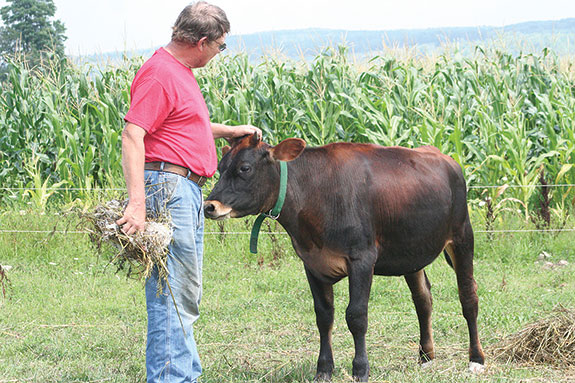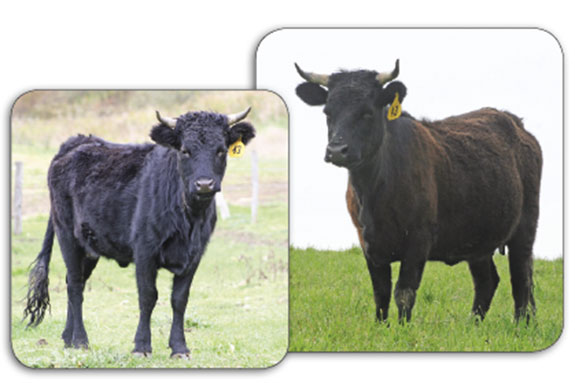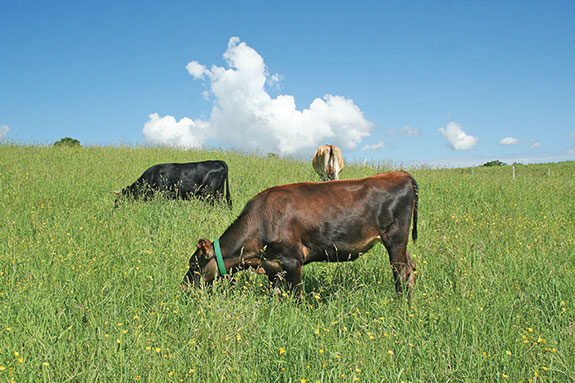For one such multi-generational livestock operation, Barrows Farm, of Lisle, New York, owned by Rich Barrows and Doreen Barker, rotational grazing has provided such a strategy, allowing the couple to slowly expand their growing herd of dairy and Irish Dexter cattle on limited acres.
This is especially important as land availability is a limiting factor for many farms considering expansion in the region.Five years ago, the pasture Rich and Doreen now graze their small cattle herd on lay fallow.

After an unsuccessful attempt at pasture leasing the field to a local dairy, Barrows Farm decided to take a different approach. Perhaps herd expansion was in their future?
However, with their limited land capacity, alternative management styles needed to be considered.
Through the suggestion of their local Farm Service Agency office, Rich and Doreen began to consider switching their management over from a continuous to a rotational grazing system.
To accomplish this transition they would start small, beginning with a 4.5-acre pasture, eventually expanding to a total of approximately 18 acres.
It is well known that a properly managed rotational grazing system provides many benefits to both the land and the livestock – by increasing soil fertility, plant health and growth, and forage utilization by livestock.
While the benefits are apparent, for many new to this type of grazing, including Rich and Doreen, how exactly to go about transitioning over to a more management-intensive grazing system can be slightly overwhelming at the start.
In Barrows Farm’s case, access to information on rotational grazing was very limited to them locally. They were starting from scratch but didn’t have a recipe.
In order to learn more, they took to social media and conducted Internet searches to find the information they needed.
Through media avenues such as Facebook, Twitter, and YouTube, she was able to connect with others who had conducted similar management changes on their farms.
Ultimately, Doreen found what she describes as a community of similar agriculturalists that, at times, serve as a better information source for grazing management information than many extension or government agencies.
In addition to the online community Doreen formed, Barrows Farm was also able to receive guidance on paddock layout and design from Dan Williams of Williams Fence of CNY, also a fellow rotational grazier.
Fast-forward to the present and Barrows Farm has been successfully rotational grazing their small herd for over a year now.

In this short time, they have noticed several key benefits, including better body condition of their cattle and increased milk production when animals are moved to new grazing more frequently.
In addition to better animal performance, a noticeable increase in forage yield and utilization has been seen.
Doreen estimated this past grazing season’s forage yields to be approximately 2.25 tons per acre, a much higher number than compared to the 1.5 tons per acre these same pastures yielded in the past.
Through trial and error, Rich and Doreen have developed their own form of pasture monitoring to assist in their grazing management.
After animals are moved to new grazing, pastures are evaluated and any standing forage is mowed to keep grasses at a similar height, but also being sure to leave adequate residual to ensure plant regrowth.
Through this practice, Rich and Doreen have noted a better ability of the soil to retain moisture when plant litter size is smaller (from using a small, finer mower compared to a larger brush hog, for example).
This practice has been especially helpful as parts of New York experienced brief droughty periods during the past grazing season.
By increasing their soil’s ability to retain moisture, Rich and Doreen were able to maintain their pastures in better condition than those still utilizing a continuous grazing system.
Doreen has also incorporated taking photos, such as fence-line contrasts, as a method of pasture monitoring.
Like any aspect of farming, to effectively manage their grazing Rich and Doreen have learned that monitoring is vital to their ability to adapt and change management strategies through the grazing season. Photo monitoring allows one quick, yet useful way to do just that.
With their first year of rotational grazing under their belt and plans for future expansion of their grazing program, Rich and Doreen are confident they can handle whatever comes next.
Future plans for Barrows Farm include permanently fencing an additional 80 acres for grazing, doing more strip grazing with annual crops such as triticale and moving calving season to early spring in order to match peak lactation periods with forage growth curves to optimize production.
When asked what advice they had for other producers considering making the jump from a continuous to a rotational grazing system, Rich and Doreen offered the following:
• Get back to the basics – You don’t need a $125,000 tractor to get started in rotational grazing. With minimum investment you can get a simple paddock system going.
• Start on a small scale – If changing over your entire farm to a new management system sounds intimidating, try starting on a trial basis. Try rotationally grazing a few animals on a small area to start. Once you’re comfortable with that, go bigger.
• Use social media – These networks can prove to be valuable discussion forums and learning places. Doreen’s favorites are Facebook and Twitter because they allow for more direct interaction and socialization. Rich mainly utilizes YouTube due to his self-proclaimed inability to type.
• Visit other farms – Seek out others doing what you want to do. Many rotational graziers are happy to provide farm tours, talk with others about what they are doing and offer help to newcomers.
• Ask questions – It is important to remember to always ask questions. No question is a bad question. It is the only way you will truly learn.
• Monitor and record – Keep a running log of your management strategies. This can be done through a journal, photos or whatever works best. Just keep track of what’s going on. This information will come in handy down the road.
Through this learning experience, Rich and Doreen have become more aware of their forage and land resources.
By doing so, they in turn have become better land managers. Recognizing the need for change is half the battle; implementing it is a whole other story.
However, with the accessibility of information via the Internet and social networks, even the most remote farmers can obtain the knowledge and guidance they need to implement successful management changes on their operations. FG
Bussard is a freelance writer based in Bozeman, Montana.
PHOTOS
TOP: In only a year of rotational grazing, Barrows Farm has seen a noticeable increase in forage production (from 1.25 tons/acre in 2011 to nearly 2.5 tons/acre in 2012).
MIDDLE: Rich Barrows and his wife, Doreen, have learned that monitoring is vital to their ability to adapt during the season.
BOTTOM: Before and after images of the same heifer after one season of rotation grazing. Note the improved body condition. Photos courtesy of Jesse Bussard.











